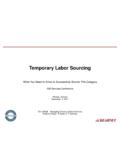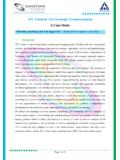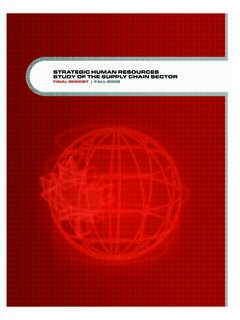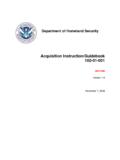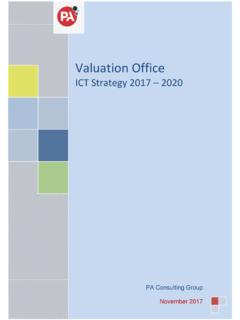Transcription of IT Strategic Audit Plan - AABRI
1 Journal of Technology Research, Volume 1 IT Strategic Audit plan , Page 1 IT Strategic Audit plan Marc Ackerman Beth Rucker Anecia Wells Joseph Wilson Randy Wittmann Jacksonville University Abstract IT Governance and Strategy are critical to a successful enterprise. Corporate executives must formulate governance plans and strategies, as well as accompanying policies and procedures, to concurrently enable the company to achieve its Strategic vision, support Audit requirements, manage risk, and exhibit responsible financial management (Swanson & Brewer, 2007). Formal Audit processes are utilized to determine if IT governance and strategy are functioning as intended. This research paper will summarize key components of an IT Strategic Audit plan , including why the processes and components are important. It will conclude with a mock Audit designed to demonstrate the types of findings that might result from an Audit of an organization s IT strategy.
2 The mock Audit is based on an actual company. The company name has been withheld based on confidentiality requirements. Keywords: Strategic Audit , strategy, IT, information technology, Audit plan Journal of Technology Research, Volume 1 IT Strategic Audit plan , Page 2 IT Audit plan Process Understand the Business 1. Identify the organization s strategies and business objectives 2. Recognize the risk profile for the organization 3. Assess how the organization structures its business operations 4. Comprehend the IT service support model Define the IT Universe 5. Analyze the business fundamentals 6. Isolate significant applications that sustain the business operations 7. Distinguish critical infrastructure for the significant applications 8. Appreciate the role of supporting technologies 9. Categorize major projects and initiatives Perform Risk Assessment 10.
3 Evaluate business and IT processes to identify risk 11. Assess risks and rank Audit subjects using IT risk factors 12. Assess risks and rank Audit subjects using business risk factors Formalize Audit plan 13. Choose Audit subjects and group into distinct Audit actions 14. Establish Audit cycle and frequency 15. Attach appropriate actions based on management requests or opportunities for consulting 16. Confirm the plan with management Process Overview An IT Strategic Audit should be conducted with the view that the primary purpose of an organization s technological resources is to support their business objectives and these technologies should be considered a risk to the organization if their failure thwarts attainment of those objectives. The first step in planning and then conducting an IT Strategic Audit is to define and evaluate an organization s objectives, strategies, underlying business model, and the role of technology in the support of that business.
4 Once this is accomplished, a risk assessment can take place. That is to say, each technology employed can be evaluated in terms of the risk that it poses to the organization achieving its specific business objectives. Overall, this outlines the basis for developing an IT Audit that aligns with business direction and Strategic goals. Therefore, it is imperative that an Audit design incorporates a definitive structure allowing for assessment of the functional relationship of IT and core business objectives. Chronologically, an IT Strategic Audit should first assess the understanding of business objectives. Secondly, the IT Universe must be assessed to determine the level of IT support for the business, including, operations, production (if applicable), marketing and development. Thirdly, risk assessments must be performed to ensure representation of precise understanding of business goals and culture.
5 Lastly, based on these prerequisite steps, formulation of a successful IT Strategic Audit plan incorporating the fundamentals of the business model, IT and risk is achievable. Figure 1. Journal of Technology Research, Volume 1 IT Strategic Audit plan , Page 3 IT is the fundamental backbone of any business that allows for potential growth and development in desired markets. It is crucial to realize whether IT governance represents the core business goals as resource allocation generating revenue growth versus declining trends maximizing business opportunity. The following sections provide additional details on how this Strategic Audit design optimizes the value of the results and benefit to business growth. Understanding the Business Since each organization is unique, the IT Strategic Audit plan should be defined by an organization s underlying business model.
6 Once the business model is understood, the auditor will have a better sense of how technology is being utilized to meet business objectives. The following internal resources provide detailed information pertaining to an organization s goals and objectives: 1. Mission, vision and value statements 2. Strategic plans 3. Annual business plans 4. Management performance scorecards 5. Stockholder annual reports 6. Regulatory filings (SEC) Once an organization s Strategic objectives are determined, it is possible to identify the key business processes that are essential for meeting those objectives. A business process is considered key if its failure inhibits the organization from arriving at the Strategic objective it is linked to. Operating units such as manufacturing, sales, and distribution should be examined at the process level. Supporting functions of management should also be examined, such as governance, compliance, finance, and human resources.
7 As soon as the key processes are identified, the Audit plan must outline the important applications and critical IT infrastructure that supports these applications. The IT processes that underlie these applications are systems development life cycle, change management, operations, and security procedures. Defining the IT Universe According to the Global Technology Audit Guide (GTAG) published by The Institute of Internal Auditors (2001), there are eight IT environment factors that are essential to understanding an organization s IT universe. First, the degree of system and geographic centralization should be examined. Whether or not an organization maintains a centralized or decentralized organizational structure will influence decision-making and allocation of IT resources. The second factor is what types of technologies have been installed.
8 There may be great diversity in any level of the IT stack, warranting investigation in a specific application s program code, database, operating system, and network infrastructure. The third factor is the degree of customization. Some business processes may have required customization of off-the-shelf software, thus creating more reliance on in-house technical support versus the original vendor(s). The fourth factor is the degree of formalized company policies and standards that define IT governance. According to Peter Weill, IT governance is specifying the decision rights and accountability framework that encourages desirable behavior in the use of IT (Weill & Ross, 2004). The fifth factor is the degree of regulation and compliance in a particular industry. An organization s regulatory requirements must be considered in the risk profile and IT Audit Journal of Technology Research, Volume 1 IT Strategic Audit plan , Page 4 universe.
9 Any organization registered with the Securities and Exchange Commission is required by the Sarbanes-Oxley Act to report on the effectiveness of their internal policies for financial reporting. The sixth factor essential to understanding an organization s IT universe is the degree and method of IT outsourcing. Although outsourcing IT may bring significant cost savings, it carries with it additional levels of risk that may be country-specific. The seventh factor is the degree of operational standardization. This will impact the reliability and integrity of the IT infrastructure and related processes. The eighth factor influencing an auditor s understanding of an organization s IT universe is the level of reliance on technology in that organization. The more an organization relies on the availability and functionality of different technologies in the IT universe in day-to-day business operations, the more the potential risk increases (Rehage, Hunt, & Nikitin, 2008).
10 Performing the Risk Assessment One of the primary goals of the risk assessment process is to understand the Strategic goals and objectives of the business and what role IT plays in support of or assisting in the achievement of said goals. Practice Advisory 2110-1 issued by the IIA identifies five key objectives of the risk management process (Institute of Internal Auditors, 2001): 1. Mission, vision and value statements. 2. Identification of business strategy risk, and prioritization of associated activities. 3. Determination by management and the board of the acceptable risk level, including signoff on risks associated with accomplishing the company s Strategic plans. 4. Design and implementation of risk mitigation activities to reduce or otherwise manage risk to levels that management and the board deem acceptable. 5. Creation of ongoing monitoring activities to periodically reassess risk, and the effectiveness of risk management controls.










